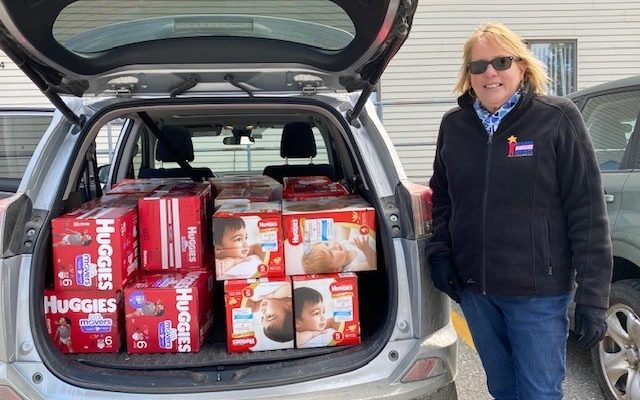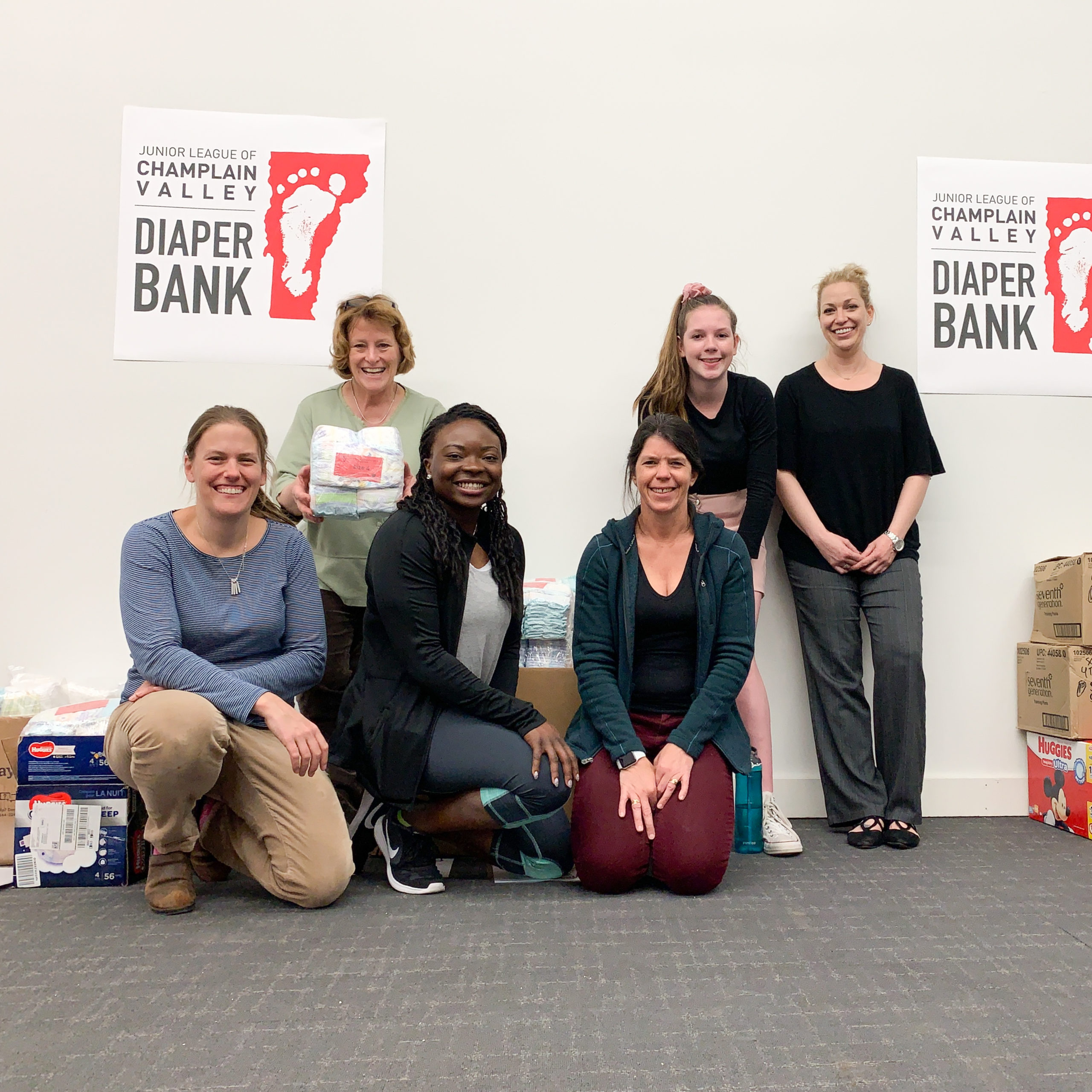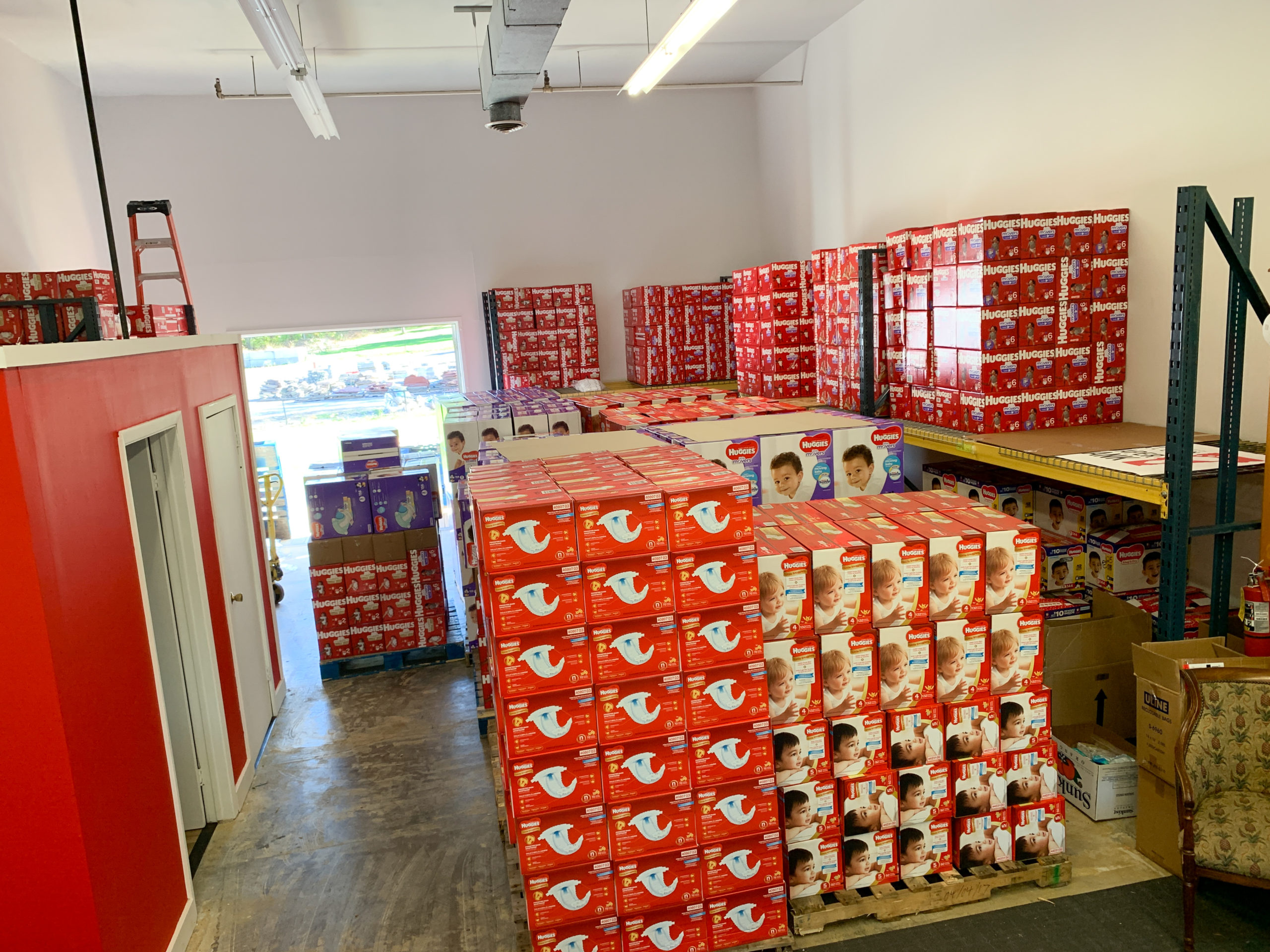
This blog is written in conjunction with Amanda Herzberger. Amanda has been a member of the Junior League of Champlain Valley for eight years and previously served as Co-President. When she’s not wearing her “diaper lady” hat Amanda is a wedding and portrait photographer and lives in Shelburne with her husband Jeff and their two young girls Norah & Julia. She loves to quilt and read and is passionate about finding a statewide solution to end diaper need in Vermont.

Intro: How the Junior League of Champlain Valley Diaper Bank Came to Be
Back in 2017, we learned from the Chittenden Emergency Food shelf (now Feeding Chittenden) that 8-10 families per day were asking for diapers and that they rarely, if ever, had a supply. We further learned that Vermont was one of only two or three states to not have a National Diaper Bank Network affiliated bank anywhere in the state.
We began by planning a diaper drive in the winter of 2017 to learn the ropes and lay the groundwork for a possible bank. We collected 18,000 diapers in early 2018 and passed them along to Feeding Chittenden. At that point we were running it out of our garages and storage rooms and transporting diapers in our cars (mine permanently smelled like baby powder!) Shortly after that, Seventh Generation approached us with a donation of 46,000 diapers. We were so thrilled and knew that it was time for an official space – which we found and moved into in the summer of 2018.
Our first distribution to our growing list of six food shelf partners was in November 2018 and since then we have been growing steadily in both number of partners and number of diapers distributed. Pre-COVID, we had expanded to partner with nine food shelves (https://www.jlcv.org/dist-partners) and made bi-monthly distributions totaling slightly over 100,000 diapers per year. Diapers were packaged in bundles of 25 for food-shelf-distribution equity and we were slowly growing our volunteer base beyond our Junior League members. We became members of the National Diaper Bank network and were able to secure over 200,000 diapers through that organization in the summer of 2019.
Since March, COVID has changed everything; as a result we’ve been temporarily providing diapers to agencies and food shelves around the state. We’ve now given out over 200,000 diapers in the year 2020!
Can you tell us a bit more about diaper need in Vermont?
Almost everyone is aware of food insecurity but I still meet so many people who aren’t familiar with diaper need, and indeed before we got started it wasn’t on our radar either. Studies show that 1 in 3 families struggle with diaper need and obviously these numbers have grown during the COVID crisis. Diaper need is the lack of a sufficient supply of diapers to keep an infant or child clean, dry, and healthy.
Infants require up to 12 diapers per day (toddlers around 8) and we all know that diapers are EXPENSIVE. Many families are having to make impossible choices between spending money on diapers or food. If families don’t have a sufficient supply of diapers they may delay changing a dirty diaper which results in negative health consequences (e.g., urinary tract infections), significant discomfort for the child, and stress for the parents.
Diapers are definitely an item of high need/hard to find item for families during the COVID-19 pandemic. This spring and summer BBF Regional Coordinators from all over the state have partnered with you and the Junior League of Champlain Valley Diaper Bank to help get diapers to families, and we are so grateful for your partnership. Can you talk about how forming creative partnerships has helped expand your reach in this time of need?
As soon as COVID hit it was clear that the need would be great, and with a robust inventory we wanted to do as much as we could. We reached out to a few contacts around the state and put the word out that although we still couldn’t serve individuals (due to our bank being entirely run by volunteers) we would do whatever we could to serve other agencies beyond our typical food shelf partners. Since March we’ve served agencies in eleven counties (we typically only serve Chittenden & Franklin counties) and have tried to be creative with the organizations we’re reaching out to. Food shelves saw their operations completely change as a result of COVID so for a while it seemed that they just didn’t have the bandwidth to deal with diapers in addition to food. Thus we worked with other social service agencies that might be serving the same populations and were able to get diapers out the door for those families. We continue to build relationships and contacts statewide to serve as many Vermonters as we can.
What have been some of the most important lessons learned so far in terms of your operations?
Before COVID I would frequently see diaper bank related information about disaster planning (hurricanes, wildfires, etc.) and think that nothing like that could ever happen in Vermont — how wrong I was! I think we’ve learned to be more nimble these past few months and just get the job done however different it looks from our operations in the past. We’ve kept strict safety protocols in place and haven’t had multiple volunteers working together yet so we’ve relied more on individual volunteers. I’m grateful that Vermont is such a small and supportive state — it seems like the social service agencies are connected and all seek to work together resulting in better outcomes for families and kids.
Our friends at the VT Early Childhood Advocacy Alliance recently informed us about the COVID-19 Relief Funds you have received from the legislature to support statewide diaper distribution through the end of the year. Moving diapers around the state is no small feat, how can BBF and other regional partners help?
Thanks for asking! We’re still trying to adapt our model especially for the southern part of the state that isn’t as easily driveable from our South Burlington warehouse. It would be helpful to know who needs diapers (i.e. if you are an agency that does — reach out! — jlcvdiaperbank@gmail.com) and based on numbers that will help us figure out the how! We have some potential partners that have offered transportation services so we are putting all the pieces together in the coming weeks.




